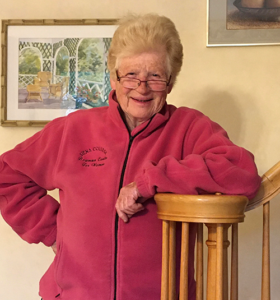 I began writing in elementary school. My first “book” was entitled, “Diary of a Blue Jay,” and in it I imagined what the world might look like on a daily basis for a blue jay that lived in our backyard cherry tree and once picked a hole in the head of my cat. No doubt the cat had destroyed her nest, but still I wondered if the punishment fit the crime. I needed to find out and so I wrote.
I began writing in elementary school. My first “book” was entitled, “Diary of a Blue Jay,” and in it I imagined what the world might look like on a daily basis for a blue jay that lived in our backyard cherry tree and once picked a hole in the head of my cat. No doubt the cat had destroyed her nest, but still I wondered if the punishment fit the crime. I needed to find out and so I wrote.
I also wondered why my cat didn’t just run and hide from the dive-bombing bird but that would have been another book, and I never got around to writing that one.
As an academic I wrote and wrote, then wrote some more, and would tell those who were not academics or did not write that the 6-hour writing day was bloody. When I quit the University, I also quit smoking. Smoking and writing had been my constant companions since high school. Thoreau once famously said, in effect, no walking, no writing. For years, I said, no smoking no writing. It took me ten years to come back to writing as a non-smoker. Now I just chew gum and guzzle diet soda and try to forget how much I miss smoking.
Writing about my experiences as a gardener has taken me to a whole new relationship with words. I hope you enjoy reading my newsletters and essays as much as I enjoy the experiences that I record and the act of recording.
Out in the Garden, and other writings
“Cricks, Crawdads, Cows, and Cornfields’/ “Stuck”/ “Temptation,” Hypertext, Spring/Summer 2022, Vol. 10
“Try Me,” New York Times Modern Love, December 3 and 5, 2021
“In Praise of Grass,” North Dakota Quarterly, vol. 88, nos. 3/4, Fall/Winter 2021
“Lineage,” Epoch, issue 3, Summer 2021
“Free to Say,” Reception, volume 13, 2021 [essay on The Resisting Reader, for a volume on its impact over the years]
“Haunted by Beatrix Farrand,” Women’s Studies Journal, Volume 50, issue 5, Spring 2021
“Travelling to Instagram,” Trolley, Issue 5, Summer 2020
“Toad,” Minute Magazine, issue 12, July 2020
“I must have that plant,” Memoirist, May 2020
“Cleveland Select,” An Eclectic Bestiary, eds. Spengler and Tischleder, 2019
Selected Books
The Resisting Reader: A Feminist Approach to American Fiction, 1978. Explores the role gender plays in shaping the form and content of canonical American fiction.
Provisions: A Reader from 19th Century American Women, 1985. An anthology of the work of women writers in the 19th century, previously unrecognized and unacknowledged.
Writing out of Place: Regionalism, Women and American Literary Culture, 2003. Discovers and explores an indigenous tradition of American writing, created by women between 1848 and 1920, Seneca Falls Women’s Rights Convention and the ratification of the 19th Amendment giving women the right to vote.
Selected Articles
“Teaching and ‘My Work,’” 2005
“Dreaming the Future of English,” 1999
“Cather and the Fiction of Female Development,” 1993
“Little Women: Alcott’s Civil War,” 1979
“Disenchantment: Tom Sawyer in Huckleberry Finn,” 1972
Since Greta Gerwig’s 2019 movie version of Little Women, interest in Alcott’s text has grown. I think Gerwig did a terrific job highlighting the conflicts and contradictions in the book. Here is an excerpt from my 1970’s take on Alcott,“Little Women: Alcott’s Civil War”:
The imaginative experience of Little Women is built on a paradox: the figure who most resists the pressure to become a little woman is the most attractive and the figure who most succumbs to it dies. Jo is the vital center of Alcott’s book and she is so because she is least a little woman. Beth, on the other hand, is the least vital and the least interesting. She is also the character who most fully internalizes the overt values of Little Women; she is the daughter who comes closest to realizing the ideal of imitating mother.